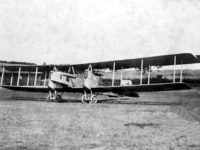The designer Hans Burkhard, who was already involved in the development of the G.II, took over the basic features of the predecessor model in the Gotha G.III, but had stronger engines installed and improved the field of fire.
Development and construction:
In the development of Gotha G.III almost all features of G.II were adopted. By the designer Hans Burkhard only those deemed unreliable Mercedes D IV were exchanged for the more powerful Mercedes D IVa, as well as for the rear shooter drilled a hole in the fuselage, so that this could also shoot down to fend off enemy aircraft.
A total of 25 pieces were built by this bomber.
Use in the First World War:
The first Gotha G.III bombers were deployed in the Balkans. There, the aircraft managed to destroy some railway bridges across the Donau and thus severely disrupt the supply of enemy troops.
Some of the bombers also arrived on the western front and were used there until September 1917.
Technical specifications:
| Designation: | Gotha G.III |
| Country: | German Empire |
| Typ: | Bomber |
| Length: | 12,2 meters |
| Span: | 23,7 meters |
| Height: | 3,9 meters |
| Mass: | 2383 kg empty |
| Crew: | Max. 3 |
| Engine: | two water-cooled 6-cylinder inline engines Mercedes D IVa with each 260 hp |
| Maximum speed: | 136 km/h |
| Reach: | 800 kilometers |
| Armament: | 2 x 7 92 mm Parabellum LMG 08/15 machine guns and up to 500 kg bombs |
You can find the right literature here:
Fokker Dr I Aces of World War 1 (Aircraft of the Aces)
Undoubtedly the most famous fighter type to see service on either side during World War 1, the Fokker Dr I was a revelation when it entered service on the western front in 1917. Manfred von Richthofens JG 1 circus was the first Jasta to completely re-equip with the new fighter, and in the skilled hands of its numerous aces the Dr I proved a formidable opponent. The Dr I remained in service on the Western Front until replaced by the superior Fokker D VII in May 1918. Just weeks prior to that, however, Germanys leading ace, the great Red Baron, had been killed at the controls of a Dr I.
Friedrichshafen Aircraft of WWI: A Centennial Perspective on Great War Airplanes (Great War Aviation) (Volume 21)

Friedrichshafen Aircraft of WWI: A Centennial Perspective on Great War Airplanes (Great War Aviation) (Volume 21) Paperback – February 16, 2016
This book describes and illustrates the development of Friedrichshafen aircraft of WWI with text, 540 photos, 18 in color, 37 color profiles, production quantities and serial numbers of aircraft, and aircraft dimensions and performance specifications. In addition, there are 26 official SVK drawings and 11 aircraft are illustrated in scale drawings to 1/48 (4) or 1/72 (7) scales. The book has 312 pages and is of interest to aviation historians, enthusiasts, and modelers alike.
German and Austro-Hungarian Aircraft Manufacturers 1908-1918
Much has been written about the British aircraft of the First World War, but little has surfaced about the aircraft of the Axis powers, Germany and Austria. Here, Terry C. Treadwell tells the story of the aircraft from companies such as Fokker, builder of the famous triplane, as fl own by Baron von Richthofen's Flying Circus, AEG, Albatros, Junkers and Hansa. From reconnaissance aircraft to state-of-the-art bombers that could reach London, this is the definitive guide to aircraft of the Axis powers during the First World War. The aircraft are explained in detail and a history of each company is provided, making this an excellent source book for aircraft enthusiasts, model makers and those interested in the air war over the trenches of France and Belgium, as well as further afield in the Italian campaign.
The Zeppelin in Combat: A History of the German Naval Airship Division
The standard reference now revised and expanded. Dr. Robinson has opened up his vast photo archives to enhance this new edition of his classic work. Much of the new photographic material is published here for the first time.
This post is also available in:
 Deutsch (German)
Deutsch (German)  Français (French)
Français (French)  Italiano (Italian)
Italiano (Italian)  简体中文 (Chinese (Simplified))
简体中文 (Chinese (Simplified))  Русский (Russian)
Русский (Russian)  Español (Spanish)
Español (Spanish)  العربية (Arabic)
العربية (Arabic)
















